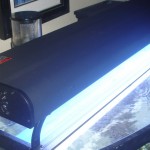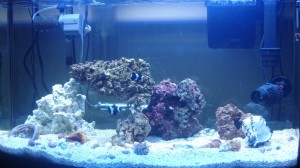As I discussed in my first post, the major reason why I decided to create this blog is because I had so much trouble finding information on the Internet regarding marine and reef aquariums. This was particularly true for lighting. I knew I needed better lighting to support corals and other invertebrates, but from there I didn’t have a clue. The sites that were trying to explain reef lighting were mostly from the late 90’s to the early 2000’s, and were completely missing newer technology. Even those that did discuss new technology were confusing – they used old style wattage estimates to calculate the amount of light required for a given size aquarium, even for the much more efficient T5 lighting.
This is what I know now, after piecing details together. There are 5 main lighting technologies that are popular for reef aquariums today:
- T8 and T12 florescent bulbs, Normal Output (NO)
- T8 and T12 florescent bulbs, Very High Output (VHO)
- Compact Florescent bulbs
- Metal Halide bulbs
- T5 florescent bulbs, High Output (HO)
T5, T8, and T12 are all just signifying the diameter of the florescent bulbs, in 1/8th inch increments. So, a T12 is 12/8ths of an inch, or 1 and 1/2 inches in diameter, while a T5 is 5/8ths of an inch in diameter. T8 is the size of florescent bulbs we are most used to today. T8s and T12s seem to be giving way to Compact Florescent and T5. T5s are the up and coming thing, because they are new and much more efficient than the T8s and T12s, and even the Compact Florescent bulbs. The NO florescent bulbs are what you buy for household lighting, and are frequently used for standard marine and fresh water aquariums. VHO bulbs are a much brighter bulb, and require a higher wattage ballast than the NO bulbs.
Compact Florescent bulbs look kind of like 2 florescent bulbs stuck together, with all of the connections on one end of the bulbs. They were designed to be very high wattage light sources in a small space. If you needed 6 VHO T8s, you might need one Compact Florescent, for example. This style of lighting is still fairly popular.
Metal Halide bulbs look more like a standard light bulb. Some reef aquarium owners prefer the Metal Halide light instead of the florescents because the corals get a wave distorted light effect similar to what the sun creates in a real reef. Florescent bulbs, on the other hand, are a constant light all along the length, and don’t give the wavy light effect. Metal Halide lights also give off much brighter light at much higher wattages than you can get with florescent bulbs.
Another important part about lighting is the spectrum of the light produced. With this hobby we are trying to model a reef that would be from 10 to 20 feet under water in some cases. Depending on the depth, the red and yellow spectrum light tends to get filtered out in water, leaving only the blue spectrum. The deeper the water, the bluer the light gets. As a result, most corals like blue spectrum light, sometimes referred to as “actinic”.
I recently found a very good blog post about the technical details of aquarium lighting. If you’re interested in all of the geeky details of what light is and how it applies to reef aquariums, definitely read that post.
I also intend to research lighting more thoroughly in the upcoming weeks. For one thing, I still want to understand how to accurately determine what kind of lights are required for a given type of coral. Also, I hear that LED based aquarium lighting may be starting to hit the markets soon.
When it came time to work out what lighting we would use for our reef aquarium, we had a couple of ideas. First, we found a Metal Halide bulb and ballast on Craig’s List for $75. Since Metal Halide systems can go up to $400, this seemed like a great deal. However, it did not have a hood with it, so I would have to make one. We even went to the local Home Depot to price materials. I had it all worked out – I would build a wood hood, about 3 feet wide and 8 inches deep. I would mount the Metal Halide bulb in the middle, and add a pair of T5HO florescent bulbs to one side. The T5’s would use the blue spectrum lighting, since Metal Halide tends to be a white light. Unfortunately, the materials for this contraption would have been quite expensive.
Instead, we decided to go with a dual lamp Compact Florescent system. You might ask, “why not the T5HO system?” The answer, budget. First, the comparable T5 system was twice as expensive as the Compact Florescent system. Second, replacing the T5HO florescent bulbs (required about once a year) would have been close to double the cost of replacing Compact Florescent bulbs. Since our aquarium is relatively small at 46 gallons, the 192 watt Compact Florescent system we purchased will be plenty of light for most corals.
Now, one benefit that I had not thought of initially is that the brighter lights allow for far superior pictures to post. So, here is the latest picture of the aquarium.

